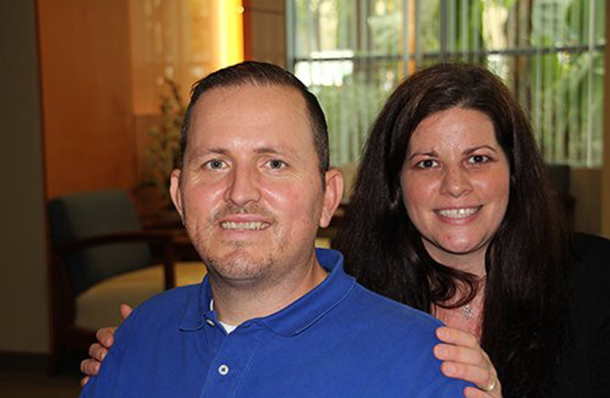NCTS Patient Stories
Living proof that NCTS heals heart to heart, one

“From generation to generation, NCTS has improved — and many times, saved — lives, including mothers and daughters, fathers and sons, brothers and sisters. And grandfathers and grandsons.”
Sean Porter
Sean Porter is reminded of that fact every time he looks into his grandfather’s eyes. Bill Porter had a heart attack and subsequent heart surgery by a NCTS doctor when he was 60. Today he is 83 and doing great.
“My Grandpa is so encouraging. He gives me hope that I will live a long and fulfilling life,” Sean, 41, says.
Often times, individuals don’t realize the significant role genetics plays in heart disease, yet for some younger individuals, it is so important to be proactive with their heart health due to family history.
Sean understands this well. Huntington Beach husband and father had to undergo a white-knuckle life-and-death struggle that began last November and lasted for several harrowing weeks.
After wrapping up coaching duties for his 12-year-old daughter’s softball season and posing for a family Christmas photo, Sean began experiencing shortness of breath. He also had been experiencing shoulder pain since last May, which he chalked up to a car accident injury from 2009. He had no explanation for the shortness of breath.
His general practitioner did an EKG; alarmed by the results, he immediately referred Sean to Dr. Subbarao Myla, a Cardiologist and Program Director for NCTS Cardiac Cath Labs.
“Sean was presenting with clear symptoms of heart failure and chest pain,” explains Dr. Myla. “He needed immediate medical care.”
Dr. Myla scheduled Sean for an angiogram at NCTS. During this, he discovered Sean had a series of blocked arteries and his heart function was very weak. Knowing the next step was bypass surgery, Dr. Myla placed a temporary Impella pump in Sean’s heart to help support the heart and maintain proper blood flow fo the next steps ahead.
Sean’s bypass surgery, performed by cardiothoracic surgeon Colin Joyo, M.D. revealed Sean had endured a series of silent heart attacks over time that left his heart dangerously covered in scar tissue. Coincidentally, it was Dr. Joyo who performed heart surgery on Sean’s grandfather 23 years prior.
Despite a successful bypass surgery, Sean’s heart began to fail during recovery and he experienced a series of cardiac arrhythmias.
His medication was adjusted, but he quickly went into cardiac arrest.
Sean flat-lined — that is, the medical team could detect no pulse or heartbeat — for a full 20 minutes. His situation was dire.
“They finally got him back,” Candace says, wiping away tears. “There were so many people in the room working on him, and one of the things I find so amazing, beyond the outstanding care he received, is that NCTS took time to worry about me and our kids. Their focus was on him, of course, but a nurse took time to walk out of the room with me and explain step by step what the doctors and nurses were doing. She gave me a hug and was so reassuring.
“It was a very difficult time but it felt like we had the best people in the world working on him. I am so grateful to NCTS that they not only took care of him, but our entire family. They treated all of us like we were all part of a family.”
Once stabilized, Sean went back to the cath lab to receive another angiogram and two stents to alleviate some of the blocked arteries. He also had the Impella pump re-inserted by Dr. Aidan A. Raney, Program Director for NCTS Cardiothoracic Surgery and James and Pamela Muzzy Endowed Chair in Cardiothoracic Surgery – the prior pump had been removed after a few days, since it is only used as a temporary support.
The medical team kept Sean sedated for several days to let his heart rest while the pump kept it beating. Meanwhile, they prepared to have him transported via helicopter to the heart transplant team at UC San Diego’s Sulpizio Cardiovascular Center.
After arriving at UCSD, Sean and his family finally received some encouraging news. The doctors there were pleasantly surprised at his condition; they had been expecting the absolute worst. “That gave us so much hope,” Candace says.
The team there gradually weaned Sean off the sedation medications so that he would wake up. But major questions abounded: Would Sean still have brain function after having flat-lined for so long and being under sedation for days? Would he be able to talk or move his arms and legs? Would he recognize his loved ones?
As he slowly woke up, it became clear that the familiar Sean that Candace and their children adored was returning. Slowly he was able to move his legs and respond to verbal commands. And then, his ability to talk returned.
“The next several days he kept asking questions about what happened,” Candace recalls. “Sean has always been really funny but he really had all of us laughing. We were overjoyed that he was alive and awake, and it was a bigger bonus that he had his sense of humor. When we told him the story of how he flat-lined, he kept saying over and over again, ‘WHAAAAAAAATTTTTT?’ in this super funny way.”
Upon discharge, Sean’s heart was functioning at 50 percent. He continues to improve to this day. His medical team at NCTS — while keeping a very close eye on him — has determined he doesn’t need a heart transplant.
Sean came home from the hospital on Dec. 20, and enjoyed what is sure to be one of the best Christmases of his life surrounded by his wife and children, and other family members and friends.
And, of course, his grandfather.
